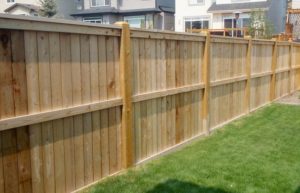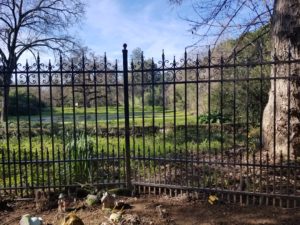Welcome to our comprehensive guide on preparing your fences for hurricane season. Living in a region prone to these mighty storms, I’ve seen firsthand how vital it is to be prepared. As a blue-collar worker, my experience with the aftermath of hurricanes has shown me the crucial role fences play in protecting properties. Too often, I’ve witnessed fences—once thought sturdy—toppled or torn apart by the ferocious winds and relentless rains. This devastation not only compromises safety but also adds to the emotional and financial strain in the storm’s aftermath.
In this guide, we’ll delve into the specifics of preparing different types of fences—wood, metal, and vinyl—for extreme weather conditions like hurricanes. Each material has its unique strengths and weaknesses when facing the wrath of such storms. Wooden fences offer a classic look but require special attention to withstand the elements. Metal fences, known for their durability, still need proper maintenance and installation to resist hurricane forces. Vinyl fencing, while low maintenance, poses its own set of challenges in extreme weather. By understanding these materials’ pros and cons, you can make informed decisions to fortify your fences against the powerful forces of nature. Join me as we explore how to best prepare and protect your fencing investment from the unpredictable and often harsh reality of hurricane season.
Understanding the Impact of Hurricanes on Fencing
The Forces at Play: Wind, Debris, and Water
Hurricanes unleash a trio of destructive forces on fencing structures: wind, debris, and water. Each of these elements plays a significant role in compromising the integrity of a fence during a storm.
- Wind: The most visible and impactful force during a hurricane is the wind. It can exert tremendous pressure on fences, testing their strength and stability. The direction and speed of wind gusts can vary dramatically, posing a constant challenge to any fencing structure.
- Debris: Flying debris, carried by hurricane winds, acts like missiles. These can include branches, rocks, or even parts of other damaged structures. When these hit fences, they can cause severe damage, such as dents, cracks, or even complete breakage.
- Water: Often overlooked, water plays a critical role in fence damage during hurricanes. Heavy rains and flooding can soften the ground, undermining fence foundations. Water exposure can also lead to material deterioration, especially in wood and certain metals.
Common Damage Types: Uprooting, Breakage, and Erosion
The types of damage fences suffer during hurricanes can range from minor to catastrophic. Understanding these common damage types helps in preparing and reinforcing fences effectively.
- Uprooting: High winds and softened soil can lead to uprooting, where fences are literally pulled out of the ground. This is particularly common in fences with shallow or weak foundations.
- Breakage: Direct impacts from debris or the sheer force of the wind can cause breakage. Wooden fences might splinter or crack, metal fences could bend or snap, and vinyl fences might shatter or warp.
- Erosion: Prolonged exposure to water, especially in coastal areas where saltwater is involved, can lead to erosion of the fence material. This is a slower process but significantly weakens the fence over time.
In the following sections, we will explore how different fencing materials—wood, metal, and vinyl—respond to these forces and what measures can be taken to mitigate the risks associated with hurricanes. Want to compare all aspects of the different materials? Read our fencing materials comparison guide.
Wood Fencing in Hurricanes

Pros of Wood Fencing
Wood fencing, a popular choice among homeowners, offers several advantages, especially in terms of aesthetics and practicality.
- Aesthetic Appeal: Wood fences provide a natural, classic look that enhances the beauty of any property. Their versatility in design allows for customization to suit various architectural styles.
- Ease of Repair: Unlike other materials, wood fences are relatively easier to repair. Damaged panels or posts can often be replaced individually without needing to overhaul the entire structure.
- Natural Material: As a natural material, wood has an organic appeal. It also has the advantage of being eco-friendly, especially if sourced from sustainable forests.
Cons of Wood Fencing
However, wood fencing faces certain challenges, particularly in hurricane-prone areas.
- Susceptibility to Water Damage: Wood is prone to water damage, which can lead to rot, mold, and weakening of the structure.
- Prone to Breaking under High Winds: During hurricanes, the rigid nature of wood makes it susceptible to breaking or splintering under high wind pressures.
- Maintenance Requirements: Wood fences require regular maintenance, including staining or painting, to maintain their integrity and appearance.
Preparing Wood Fences for Hurricanes
To mitigate these drawbacks and enhance the resilience of wood fencing in hurricanes, several steps can be taken.
- Regular Maintenance Tips:
- Inspect Regularly: Conduct thorough inspections for signs of rot, insect damage, or loose components, and address these issues promptly.
- Seal and Treat: Regularly apply sealants to protect against moisture and insect damage. Choose high-quality, weather-resistant products.
- Proper Drainage: Ensure that the area around the fence has proper drainage to prevent water accumulation.
- Reinforcement Techniques:
- Metal Brackets and Supports: Use metal brackets and supports to reinforce joints and posts, providing additional strength against wind forces.
- Post Anchoring: Secure fence posts deeply into the ground and use concrete for additional stability.
- Cross-Bracing: Implement cross-bracing techniques, especially in areas of the fence that are more exposed to wind.
- Waterproofing and Protective Coatings:
- Water-Repellent Coatings: Regularly apply water-repellent coatings to protect the wood from moisture.
- Weatherproof Paints: Use high-quality, weatherproof paints that provide an additional layer of protection against the elements.
- Anti-Rot Treatments: Treat the wood with anti-rot compounds to extend its lifespan and resilience against humid conditions.
By taking these proactive steps, wood fencing can be better prepared to withstand the harsh conditions brought by hurricanes, thereby preserving its aesthetic appeal and structural integrity.
Metal Fencing in Hurricanes

Pros of Metal Fencing
Metal fencing is often chosen for its robust characteristics, especially in regions that face severe weather conditions like hurricanes.
- Durability and Strength: Metal fences are known for their exceptional durability. They can withstand significant forces, making them a reliable choice in high-wind scenarios.
- Resistance to Water and Humidity: Unlike wood, metal is highly resistant to water and humidity, which is advantageous in hurricane-prone areas where heavy rains and flooding are common.
- Longevity: Metal fences typically have a long lifespan, often outlasting other fencing materials, due to their robust construction and resistance to environmental factors.
Cons of Metal Fencing
Despite their strengths, metal fences have certain drawbacks that need consideration, especially in the context of hurricanes.
- Risk of Corrosion: While metal is water-resistant, it is susceptible to corrosion, particularly in coastal areas where saltwater can accelerate this process.
- Potentially Hazardous in High Winds: If not properly anchored, metal fences can become hazardous in high winds, posing a risk of dislodging and becoming flying debris.
- Limited Flexibility in Design: Metal fences often offer less flexibility in design compared to wood, which might be a consideration for those seeking aesthetic customization.
Read More: Comparing difference fence materials
Preparing Metal Fences for Hurricanes
To optimize metal fencing for hurricane resistance, several preparation steps are crucial.
- Anti-Corrosion Treatments:
- Regular Application of Protective Coatings: Apply rust-inhibiting paint or coatings regularly to prevent corrosion.
- Use of Galvanized or Stainless Steel: Opt for materials like galvanized or stainless steel that offer enhanced resistance to rust and corrosion.
- Securing and Anchoring Techniques:
- Deep and Secure Anchoring: Ensure that fence posts are deeply and securely anchored into the ground, preferably with concrete foundations.
- Reinforced Attachments: Use reinforced attachments and brackets to secure panels and posts, making them more resilient to wind forces.
- Wind-Resistant Design: Consider designs that allow wind to pass through, reducing the overall wind load on the fence.
- Regular Inspections for Weak Points:
- Scheduled Maintenance Checks: Conduct regular inspections to identify and address any signs of wear, loose components, or damage.
- Post-Storm Assessments: After any storm, thoroughly assess the fence for any damages or weaknesses that need immediate attention.
- Professional Consultation: When in doubt, seek professional advice to ensure your metal fence is as prepared as it can be for hurricane conditions.
Through these preventative and maintenance measures, metal fencing can be effectively fortified to withstand the harsh realities of hurricanes, providing both security and longevity.
Vinyl Fencing in Hurricanes
Pros of Vinyl Fencing
Vinyl fencing has gained popularity due to its distinct advantages, particularly in its maintenance and durability against various weather conditions.
- Low Maintenance: One of the most significant advantages of vinyl fencing is its low maintenance requirements. It does not require painting or staining and is easy to clean.
- Weather Resistant: Vinyl is inherently resistant to many weather-related issues that affect other materials. It stands up well against rain, sun, and humidity, making it an ideal choice for varied climates.
- Does Not Rot or Corrode: Unlike wood or some metals, vinyl does not rot, corrode, or rust, which contributes to its longevity and durability.
Cons of Vinyl Fencing
However, there are certain limitations to vinyl fencing, especially when considering its performance in hurricane conditions.
- Can Become Brittle Over Time: Exposure to extreme temperatures and UV rays over time can cause vinyl to become brittle, reducing its ability to withstand impact.
- Less Sturdy in High Winds Compared to Metal: While vinyl is resilient, it is generally not as sturdy as metal in high wind conditions, which can be a concern during hurricanes.
- May Warp in Extreme Temperatures: In extreme heat or cold, vinyl fencing may warp, which can compromise its structural integrity.
Preparing Vinyl Fences for Hurricanes
To ensure vinyl fences are as prepared as possible for hurricane conditions, several key steps should be taken.
- Inspection and Replacement of Brittle Sections:
- Regular Inspections: Conduct regular inspections to check for signs of brittleness or cracking, especially in older sections of the fence.
- Timely Replacement: Replace any sections that show significant wear or damage to maintain the structural integrity of the fence.
- Reinforcement Options:
- Use of Sturdy Posts: Opt for stronger, more robust posts, possibly made of metal, to provide additional support.
- Reinforcement Inserts: Consider using reinforcement inserts within the vinyl posts and panels for added strength.
- Secure Panel Attachments: Ensure that all panels are securely attached to the posts and each other to reduce the risk of them coming loose in high winds.
- Proper Installation Techniques:
- Deep Post Installation: Install fence posts deeply into the ground, with concrete footings for enhanced stability.
- Wind Load Consideration: Choose designs that are rated for higher wind loads, especially in hurricane-prone areas.
- Professional Installation: If unsure, enlist professional services for installation to ensure all aspects of the fence are hurricane-ready.
By addressing these considerations, vinyl fencing can be a viable and enduring option even in areas prone to hurricanes, combining ease of maintenance with enhanced preparedness for extreme weather.
General Tips for All Fences
Regardless of the material, there are universal best practices to ensure fences stand the best chance against the ravages of hurricanes. These tips focus on routine maintenance, proper installation, and understanding local weather patterns.
Routine Maintenance
Regular maintenance is key to preserving the integrity and extending the lifespan of any fence, especially in preparation for hurricane season.
- Consistent Inspections: Regularly inspect your fence for any signs of damage, wear, or weakness. Look for loose boards, rusted or weakened metal parts, or any signs of deterioration in vinyl.
- Immediate Repairs: Address any issues uncovered during inspections immediately. Delaying repairs can lead to more significant damage during a hurricane.
- Clean and Treat: Keep your fence clean from debris, dirt, and foliage. Apply protective treatments as needed, such as rust prevention for metal fences or sealants for wood fences.
Proper Installation and Anchoring
The way a fence is installed plays a crucial role in its ability to withstand high winds and other stresses brought by hurricanes.
- Deep Anchoring: Ensure that fence posts are deeply anchored into the ground. The depth and method will vary based on fence material and soil type.
- Use of Quality Materials: Invest in high-quality materials for posts and anchoring systems. This could mean thicker, more durable wood, galvanized or stainless steel for metal fences, and UV-resistant vinyl.
- Professional Installation: Consider hiring professionals for fence installation. Their expertise can be invaluable, particularly in ensuring that your fence can withstand local weather conditions.
Understanding Local Weather Patterns and Preparing Accordingly
Awareness of local weather patterns is crucial for appropriate fence preparation and maintenance.
- Research Local Weather Trends: Understand the typical weather conditions and any recurring extreme weather patterns in your area. This can guide you in choosing the right fence material and design.
- Hurricane-Proofing Additions: Depending on your region, consider additional hurricane-proofing measures like windbreaks, strategic landscaping, or reinforcing accessories specifically designed for hurricane resistance.
- Building Codes and Regulations: Stay informed about local building codes and regulations related to fencing. These often include specifications designed to ensure structures can withstand local weather challenges.
Incorporating these general tips into the care and planning of your fence, regardless of its material, can significantly enhance its resilience against hurricanes. Regular maintenance, proper installation, and a keen understanding of local weather patterns are the cornerstone of effective fence preparedness for extreme weather conditions.
Conclusion
As we conclude this comprehensive guide, let’s recap the key points for each type of fencing and underscore the importance of preparation for hurricane season.
Recap of Key Points for Each Fence Type
- Wood Fencing: Wood offers aesthetic appeal and ease of repair but requires regular maintenance and protective treatments to withstand hurricane conditions. Key strategies include using water-repellent coatings, reinforcing with metal brackets, and ensuring proper drainage around the fence.
- Metal Fencing: Metal fences boast durability and resistance to water, but they must be protected against corrosion and securely anchored to prevent hazards in high winds. Regular anti-corrosion treatments and deep anchoring are vital.
- Vinyl Fencing: This low-maintenance option is weather-resistant and doesn’t rot or corrode, yet it can become brittle and less sturdy in extreme conditions. Regular inspection, using sturdy posts, and considering wind load in design are crucial.
Encouragement to Prepare Fences Well in Advance of Hurricane Season
Preparing your fence for hurricane season is not a last-minute task. It’s a crucial part of home maintenance, particularly in storm-prone areas. Start early, assess the needs of your specific type of fencing, and take proactive steps to reinforce and protect your property.
Final Thoughts from on the Importance of Hurricane-Resistant Fencing
From a blue-collar worker’s viewpoint, the value of a well-prepared fence in hurricane-prone areas cannot be overstated. It’s not just about protecting property; it’s about ensuring safety and peace of mind in the face of nature’s fury. A durable and well-maintained fence can make a significant difference in minimizing damage and recovering post-storm.



